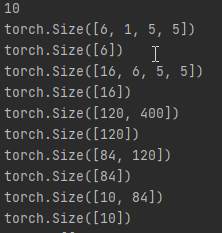This is the net code and the result of test:
class Net(nn.Module):
def __init__(self):
super(Net, self).__init__() # 初始化基类
self.conv1 = nn.Conv2d(1, 6, (5, 5))
self.conv2 = nn.Conv2d(6, 16, (5, 5))
self.fc1 = nn.Linear(16 * 5 * 5, 120)
self.fc2 = nn.Linear(120, 84)
self.fc3 = nn.Linear(84, 10)
def forward(self, x):
# Max pooling over a (2, 2) window
x = self.conv1(x)
x = f.relu(x)
x = f.max_pool2d(x, (2, 2))
# If the size is a square you can only specify a single number
x = self.conv2(x)
x = f.relu(x)
x = f.max_pool2d(x, (2, 2))
x = x.view(-1, self.num_flat_features(x))
x = f.relu(self.fc1(x))
x = f.relu(self.fc2(x))
x = self.fc3(x)
return x
def num_flat_features(self, x):
size = x.size()[1:] # all dimensions except the batch dimension
num_features = 1
for s in size:
num_features *= s
return num_features
"创建网络"
net = Net()
params = list(net.parameters())
print(len(params))
for param in range(10):
print(params[param].size()) # print parameters

I want to know the structure of the parameters
however the results show that each relu will introduce a parameter tensor , why?